The Production of Porous Asphalt Mixtures with Damping Noise Reduction and Self-Healing Properties through the Addition of Rubber Granules and Steel Wool Fibers
Abstract
:1. Introduction
2. Materials and Methods
2.1. Materials
2.2. Preparation of Asphalt Mixture
2.3. Porosity and Permeability Coefficient Tests
2.4. Cantabro Particle Loss and Water Stability Tests
2.5. Asphalt Mixture Bending Test
2.6. Hamburg Wheel-Tracking Test
2.7. Damping and Noise Reduction Performance Test
2.8. Pore Noise Reduction Performance Test
2.9. Induction Heating Test
2.10. Self-Healing Performance Test
3. Results and Discussion
3.1. Porosity of the Mixtures with Different Contents of Rubber Granules
3.2. Permeability Coefficients of Mixtures with Different Contents of Rubber Granules
3.3. Particle Loss Rates of Mixtures with Different Contents of Rubber Granules
3.4. Water Stability of the Mixtures with Different Contents of Rubber Granules
3.5. Low-Temperature Performance of Mixtures with Different Contents of Rubber Granules
3.6. High-Temperature Performance of Mixtures with Different Contents of Rubber Granules
3.7. Effect of Rubber Granule Content on Damping and Noise Reduction Performance of the Mixture
3.8. Porous Noise Reduction Performance of Mixtures with Different Contents of Rubber Granules
3.9. Induction Heating Performance
3.10. Self-Healing Properties
4. Conclusions
Author Contributions
Funding
Institutional Review Board Statement
Data Availability Statement
Acknowledgments
Conflicts of Interest
References
- Srirangam, S.K.; Anupam, K.; Casey, D.; Liu, X.; Kasbergen, C.; Scarpas, A. Evaluation of Structural Performance of Poroelastic Road Surfacing Pavement Subjected to Rolling-Truck Tire Loads. Transp. Res. Rec. 2016, 2591, 42–56. [Google Scholar] [CrossRef]
- Peng, J.; Parnell, J.; Kessissoglou, N. Spatially differentiated profiles for road traffic noise pollution across a state road network. Appl. Acoust. 2021, 172, 107641. [Google Scholar] [CrossRef]
- Azevedo, F.; Pacheco-Torgal, F.; Jesus, C.; de Aguiar, J.L.B.; Camoes, A.F. Properties and durability of HPC with tyre rubber wastes. Constr. Build. Mater. 2012, 34, 186–191. [Google Scholar] [CrossRef]
- Norambuena-Contreras, J.; Arteaga-Pérez, L.E.; Concha, J.L.; Gonzalez-Torre, I. Pyrolytic oil from waste tyres as a promising encapsulated rejuvenator for the extrinsic self-healing of bituminous materials. Road Mater. Pavement Des. 2021, 22, S117–S133. [Google Scholar] [CrossRef]
- Liu, W.H.; Xu, Y.S.; Wang, H.J.; Shu, B.N.; Barbieri, D.M.; Norambuena-Contreras, J. Enhanced Storage Stability and Rheological Properties of Asphalt Modified by Activated Waste Rubber Powder. Materials 2021, 14, 2693. [Google Scholar] [CrossRef] [PubMed]
- Chavez-Delgado, M.; Colina, J.R.; Segura, C.; Alvarez, C.; Osorio-Vargas, P.; Arteaga-Perez, L.E.; Norambuena-Contreras, J. Asphalt pyro-rejuvenators based on waste tyres: An approach to improve the rheological and self-healing properties of aged binders. J. Clean. Prod. 2024, 452, 142179. [Google Scholar] [CrossRef]
- Ling, S.; Yu, F.; Sun, D.; Sun, G.; Xu, L. A comprehensive review of tire-pavement noise: Generation mechanism, measurement methods, and quiet asphalt pavement. J. Clean. Prod. 2021, 287, 125056. [Google Scholar] [CrossRef]
- Bernhard, R.J.; McDaniel, R.S. Trb, Basics of noise generation for pavement engineers. Transp. Res. Rec. 2005, 1941, 161–166. [Google Scholar] [CrossRef]
- Zhang, X.; Liu, Y.; Liu, Z.; Yang, B. Study on Automobile Interior Noise Characteristic. In Proceedings of the International Conference on Sensors, Measurement and Intelligent Materials (ICSMIM 2012), Guilin, China, 26–27 December 2012; p. 440. [Google Scholar]
- Chu, L.; Fwa, T.F.; Tan, K.H. Evaluation of wearing course mix designs on sound absorption improvement of porous asphalt pavement. Constr. Build. Mater. 2017, 141, 402–409. [Google Scholar] [CrossRef]
- Guo, Z.-Y.; Feng, D.-C.; Shen, G.-H. Analysis of Tire-Pavement Noise Spectrum of Noise Reduction Dense Asphalt-rubber Pavement. In Proceedings of the 1st International Doctoral Annual Symposium on Intelligent Transportation Technology and Sustainable Development, Sch Transportat Sci & Engn, Harbin, China, 15–16 September 2012; p. 345. [Google Scholar]
- Lai, F.; Huang, Z.; Guo, F. Noise Reduction Characteristics of Macroporous Asphalt Pavement Based on A Weighted Sound Pressure Level Sensor. Materials 2021, 14, 4356. [Google Scholar] [CrossRef]
- Sun, J.; Zhang, H.; Yu, T.; Shi, Y.; Liu, Y. Microscopic void characteristics of OGFC in Sponge City and its effect on noise reduction performance using X-ray CT. Constr. Build. Mater. 2023, 408, 133729. [Google Scholar] [CrossRef]
- Guo, J.-T.; Zhang, R.; Wang, R. Experimental research on sound absorption performance of low-noise pavement. In Proceedings of the 4th International Conference on Technology of Architecture and Structure (ICTAS 2011), Xian Univ Architecture & Technol, Xi’an, China, 22–24 September 2011; pp. 1400–1404. [Google Scholar]
- Paje, S.E.; Bueno, M.; Teran, F.; Miro, R.; Perez-Jimenez, F.; Martinez, A.H. Acoustic field evaluation of asphalt mixtures with crumb rubber. Appl. Acoust. 2010, 71, 578–582. [Google Scholar] [CrossRef]
- Zhang, K.; Liu, Q.; Wang, J.; Wu, S. Study on induction healing properties of OGFC asphalt mixture with high elasticity and high viscosity modifier. Constr. Build. Mater. 2024, 411, 134317. [Google Scholar] [CrossRef]
- Xu, B.; Chen, J.; Li, M.; Cao, D.; Ping, S.; Zhang, Y.; Wang, W. Experimental investigation of preventive maintenance materials of porous asphalt mixture based on high viscosity modified bitumen. Constr. Build. Mater. 2016, 124, 681–689. [Google Scholar] [CrossRef]
- Yang, C.; Wu, S.; Xie, J.; Amirkhanian, S.; Liu, Q.; Zhang, J.; Xiao, Y.; Zhao, Z.; Xu, H.; Li, N.; et al. Enhanced induction heating and self-healing performance of recycled asphalt mixtures by incorporating steel slag. J. Clean. Prod. 2022, 366, 132999. [Google Scholar] [CrossRef]
- Xu, H.; Wu, S.; Chen, A.; Zou, Y.; Klemes, J.J. Influence of erosion factors (time, depths and environment) on induction heating asphalt concrete and its mechanism. J. Clean. Prod. 2022, 363, 132521. [Google Scholar] [CrossRef]
- Liu, Q.; Yu, W.; Schlangen, E.; van Bochove, G. Unravelling porous asphalt concrete with induction heating. Constr. Build. Mater. 2014, 71, 152–157. [Google Scholar] [CrossRef]
- Liu, Q.; Schlangen, E.; van de Ven, M. Induction Healing of Porous Asphalt Concrete Beams on an Elastic Foundation. J. Mater. Civ. Eng. 2013, 25, 880–885. [Google Scholar] [CrossRef]
- Liu, K.; Xu, P.; Wang, F.; You, L.; Zhang, X.; Fu, C. Assessment of automatic induction self-healing treatment applied to steel deck asphalt pavement. Autom. Constr. 2022, 133, 104011. [Google Scholar] [CrossRef]
- Jian, R.; Hu, X.; Han, T.; Wan, J.; Gan, W.; Chen, Z.; Zhang, Y.; Cao, C. Optimization of induction heating parameters for improving Self-healing performance of asphalt mixture through partial least square model. Constr. Build. Mater. 2023, 365, 130019. [Google Scholar] [CrossRef]
- Wang, D.; Yao, H.; Yue, J.; Hu, S.; Liu, J.; Xu, M.; Chen, S. Compaction Characteristics of Cold Recycled Mixtures with Asphalt Emulsion and Their Influencing Factors. Front. Mater. 2021, 8, 575802. [Google Scholar] [CrossRef]
- Qian, G.; Hu, K.; Li, J.; Bai, X.; Li, N. Compaction process tracking for asphalt mixture using discrete element method. Constr. Build. Mater. 2020, 235, 117478. [Google Scholar] [CrossRef]
- Liu, Q.; Yu, W.; Wu, S.; Schlangen, E.; Pan, P. A comparative study of the induction healing behaviors of hot and warm mix asphalt. Constr. Build. Mater. 2017, 144, 663–670. [Google Scholar] [CrossRef]
- Li, J.; Gong, Y.; Li, X.; Yin, D.; Shi, H. Urban stormwater runoff thermal characteristics and mitigation effect of low impact development measures. J. Water Clim. Chang. 2019, 10, 53–62. [Google Scholar] [CrossRef]
- Guo, Z.; Yang, Q.; Liu, B. Mixture Design of Pavement Surface Course Considering the Performance of Skid Resistance and Disaster Proof in Road Tunnels. J. Mater. Civ. Eng. 2009, 21, 186–190. [Google Scholar] [CrossRef]
- Xu, L.; Ni, H.; Tian, Y.; Sun, D.; Chen, Z.; Jin, H. Multi-scale analysis of damping characteristics of dry mixed rubberized porous asphalt mixtures for tire-pavement noise reduction. J. Clean. Prod. 2023, 425, 138969. [Google Scholar] [CrossRef]
- Wu, H.; Shen, A.; Cui, H.; Dai, X.; Li, Y.; Wang, J. Effect of Crumb Rubber Particles on Antisliding and Noise-Reduction Performance of Asphalt Pavement. J. Mater. Civ. Eng. 2023, 35, 04023118. [Google Scholar] [CrossRef]
- Chandran, V.; Nagarajan, L.; Thomas, M.R. Evaluation of vibration damping behavior of different sizes of waste tyre rubber in natural rubber composites. J. Compos. Mater. 2018, 52, 2493–2501. [Google Scholar] [CrossRef]
- Xu, L.; Ni, H.T.; Zhang, Y.; Sun, D.Q.; Zheng, Y.P.; Hu, M.J. Porous asphalt mixture use asphalt rubber binders: Preparation and noise reduction evaluation br. J. Clean. Prod. 2022, 376, 134119. [Google Scholar] [CrossRef]
- Bala, A.; Gupta, S. Thermal resistivity, sound absorption and vibration damping of concrete composite doped with waste tire Rubber: A review. Constr. Build. Mater. 2021, 299, 123939. [Google Scholar] [CrossRef]
- Zhang, H.; Liu, Z.; Meng, X. Noise reduction characteristics of asphalt pavement based on indoor simulation tests. Constr. Build. Mater. 2019, 215, 285–297. [Google Scholar] [CrossRef]
- Liu, C.; Li, L.; Bu, Z.; Luo, Y. Research on Interior Noise Distribution Characteristics of Metro in Different Vehicles. In Proceedings of the 2nd World Conference on Mechanical Engineering and Intelligent Manufacturing (WCMEIM), Shanghai Univ Engn Sci, Shanghai, China, 22–24 November 2019; pp. 676–680. [Google Scholar]
- Li, T.; Burdisso, R.; Sandu, C. Literature review of models on tire-pavement interaction noise. J. Sound Vib. 2018, 420, 357–445. [Google Scholar] [CrossRef]
- Ding, Z.-Z.; Zhao, J.-Q.; Chen, Y. Development and Evaluation of a Frequency Related Source Intensity Prediction Model of the Traffic Acoustic Noise. In Proceedings of the International Conference on Advances in Energy and Environmental Science (ICAEES), Guangzhou, China, 30–31 July 2013; pp. 162–167. [Google Scholar]
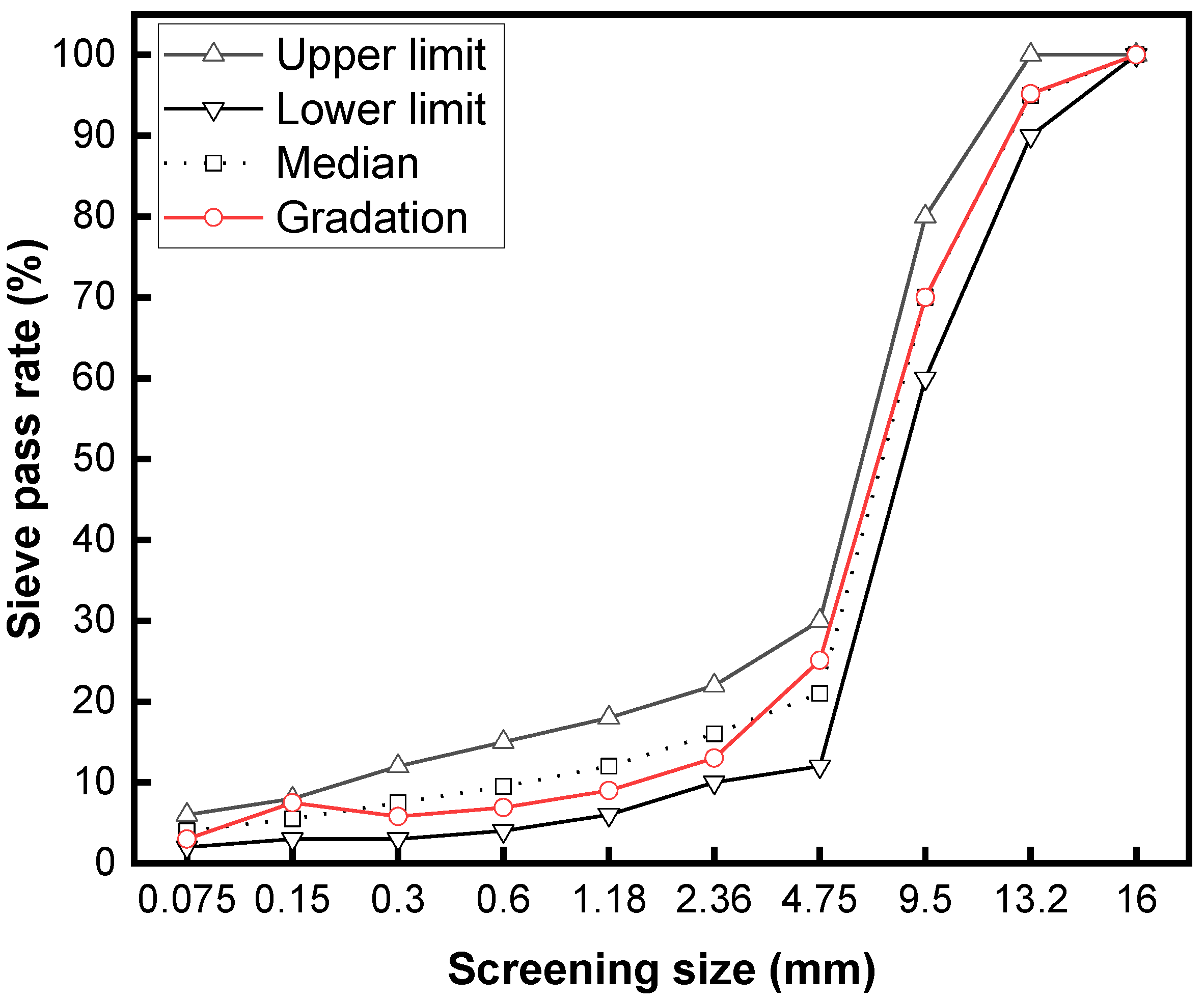

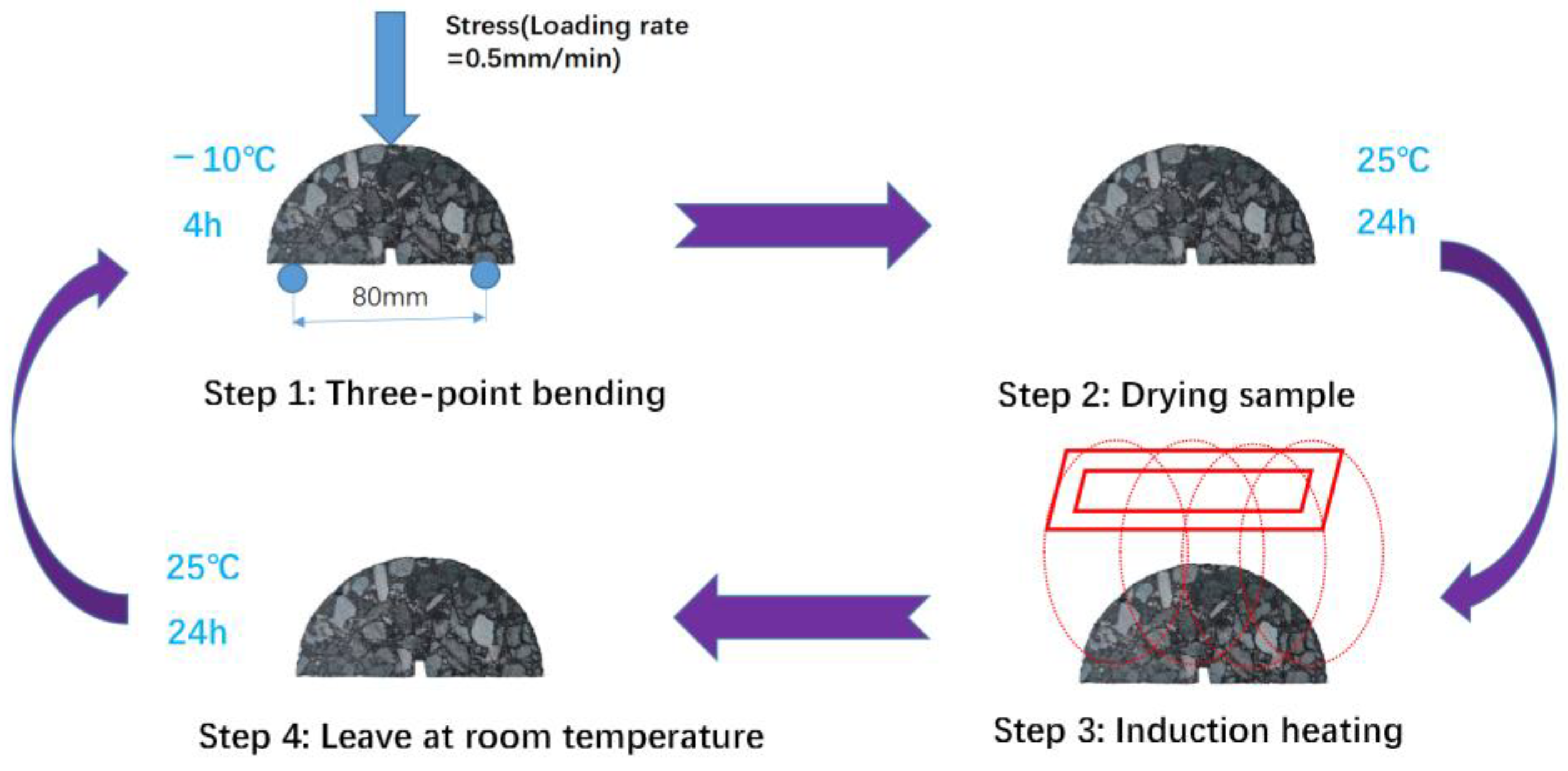




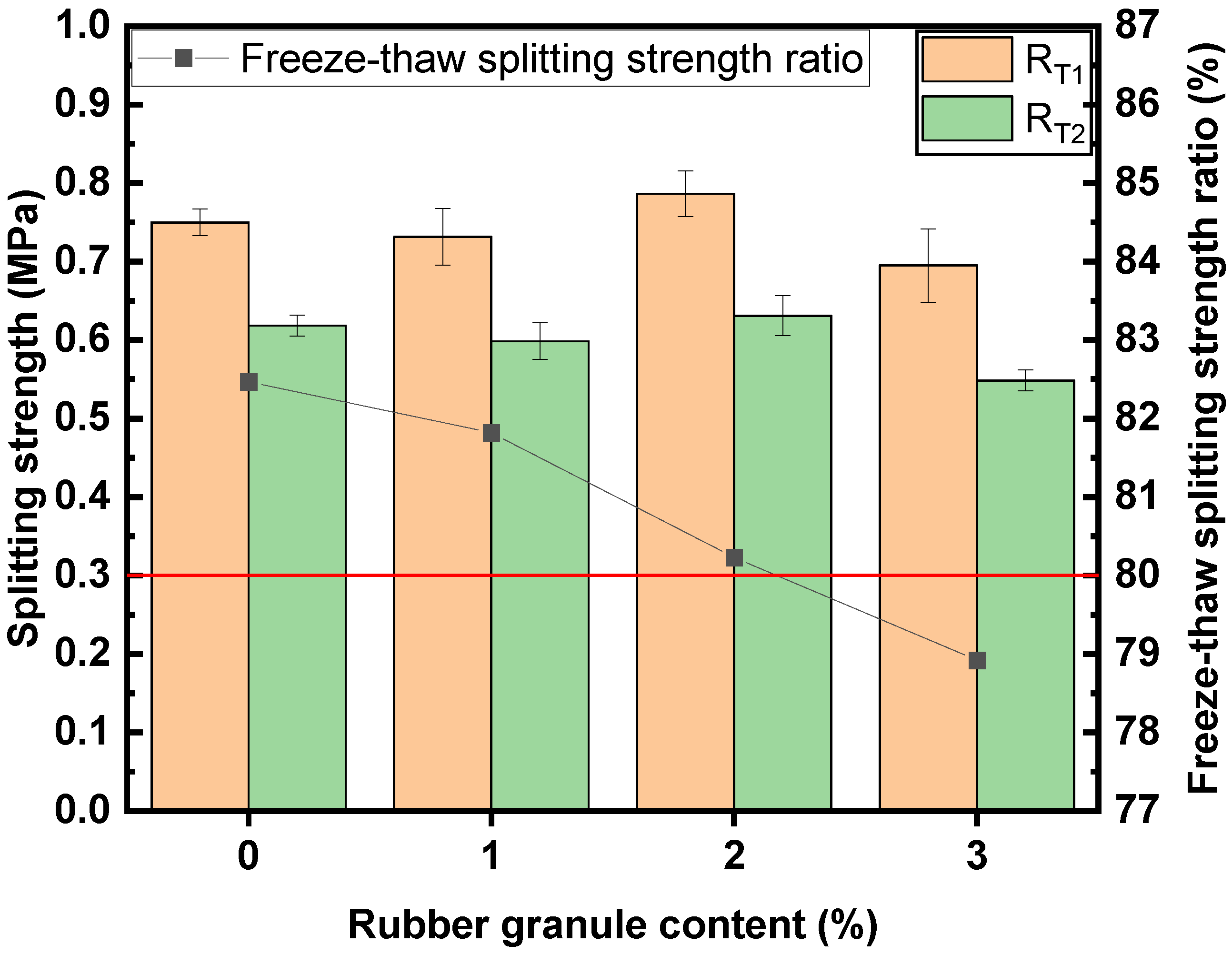



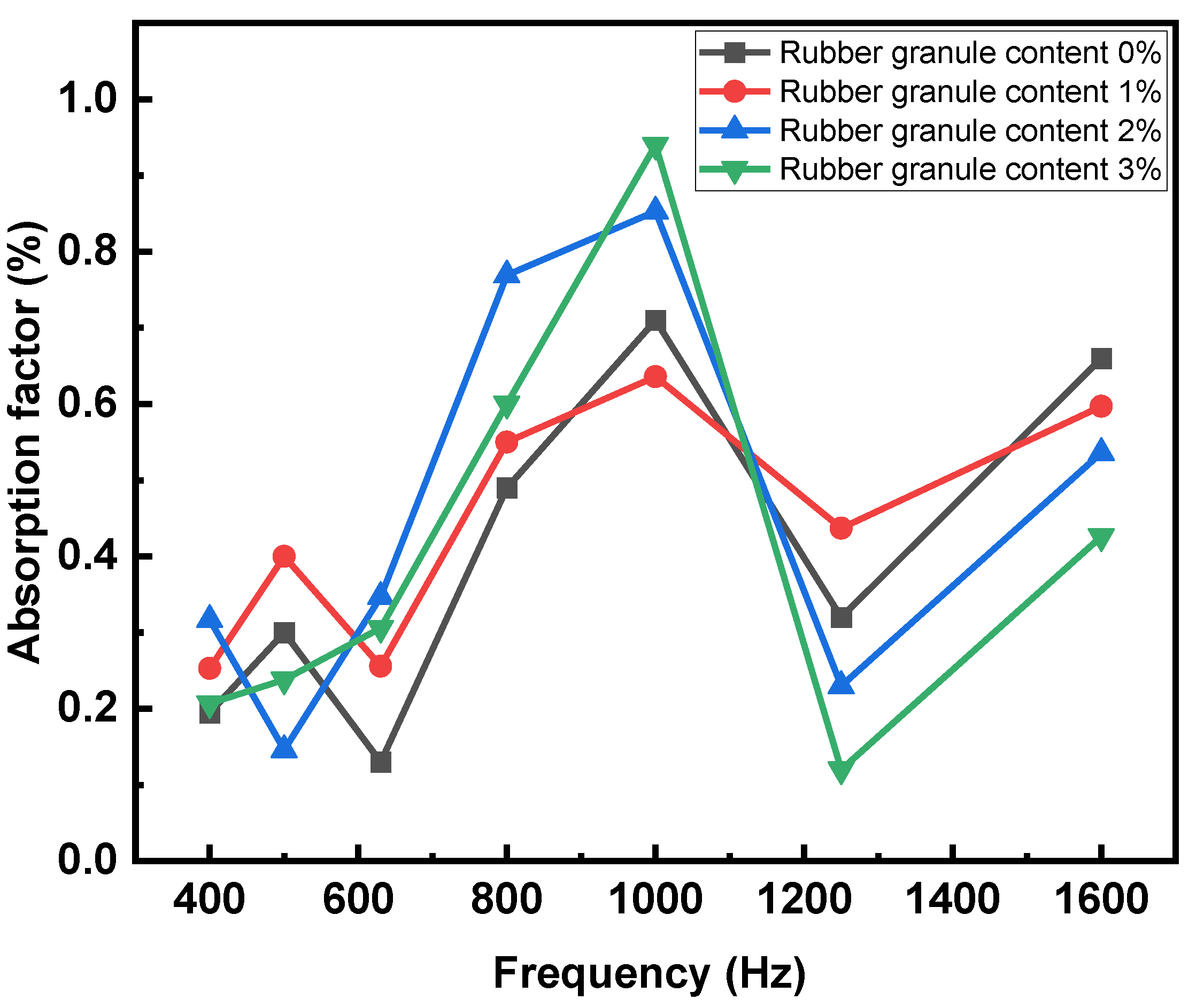
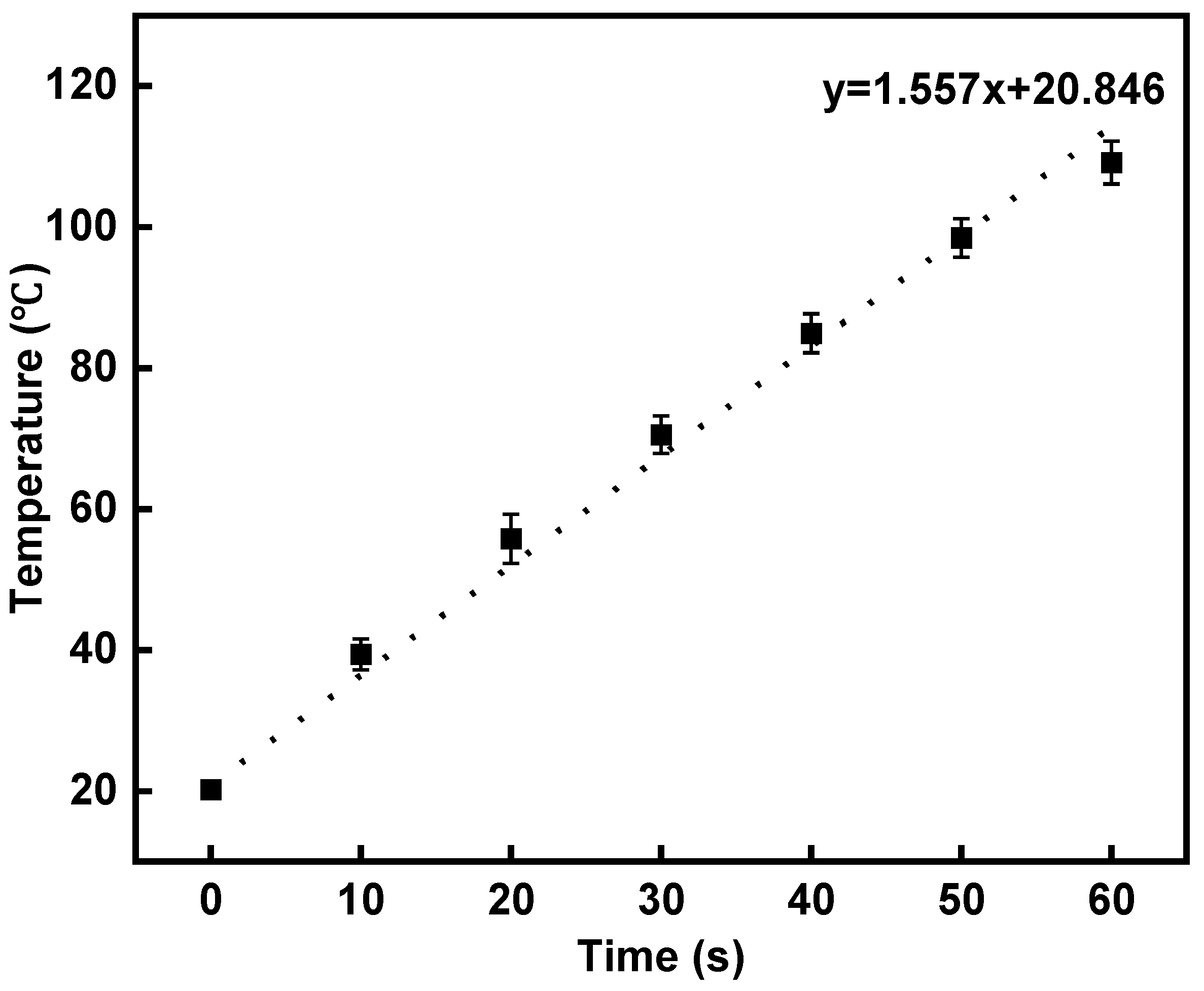

| Technical Indicators | Apparent Density/(g/cm3) | Elastic Modulus/MPa | Shore Hardness/HA | Elongated Flat Granule Content/% |
|---|---|---|---|---|
| Test results | 1.153 | 11.3 | 67 | 5.9 |
| Performance Indicators | Penetration at 25 °C/0.1 mm | Softening Point/°C | Ductility, 5 °C/cm | Viscosity at 135 °C/Pa·s | Densities, 15 °C/(g/cm3) |
|---|---|---|---|---|---|
| Test results | 56 | 75.2 | 63 | 1.132 | 1.045 |
| Requirements | 40–60 | ≥60 | ≥20 | ≤3 | - |
| Technical Indicators | Diameter/μm | Length/mm | Melting Point/°C |
|---|---|---|---|
| Test results | 70–130 | 4.2 | 1530 |
| Materials | Properties | Tested Values | Technical Requirements | |
|---|---|---|---|---|
| Basalt | Apparent specific gravity/(g/cm3) | 9.5–16 mm | 2.980 | ≥2.6 |
| 4.75–9.5 mm | 2.927 | ≥2.6 | ||
| Los Angeles abrasion/% | 10.1 | ≤28 | ||
| Crushed value/% | 10.9 | ≤26 | ||
| Adhesion level | 4 | ≥4 | ||
| Limestone | Apparent specific gravity/(g/cm3) | 3–5 mm | 2.739 | ≥2.5 |
| 0–3 mm | 2.703 | ≥2.5 | ||
| Los Angeles abrasion/% | 16.9 | ≤28 | ||
| Crushed value/% | 17.2 | ≤26 | ||
| Adhesion level | 4 | ≥4 | ||
| Limestone Powder | Apparent specific gravity/(g/cm3) | 2.694 | ≥2.5 | |
| Rubber Granule Content (%) | Bending and Tensile Stress (MPa) | Bending and Tensile Strain (με) | Bending and Tensile Modulus (MPa) |
|---|---|---|---|
| 0 | 6.66 | 3657.50 | 1820.9 |
| 1 | 6.49 | 3472.70 | 1868.9 |
| 2 | 5.92 | 3128.89 | 1892.0 |
| 3 | 5.72 | 3012.65 | 1898.7 |
| Rubber Granule Content (%) | Deformation Depth (mm) | Creep Slope |
|---|---|---|
| 0 | 4.89 | −1.60 × 10−3 |
| 1 | 6.19 | −1.99 × 10−3 |
| 2 | 7.10 | −2.47 × 10−3 |
| 3 | 7.87 | −2.93 × 10−3 |
| Rubber Granule Content 0% | Full Band Absorption Factor |
|---|---|
| 0% | 0.401 |
| 1% | 0.447 |
| 2% | 0.457 |
| 3% | 0.405 |
Disclaimer/Publisher’s Note: The statements, opinions and data contained in all publications are solely those of the individual author(s) and contributor(s) and not of MDPI and/or the editor(s). MDPI and/or the editor(s) disclaim responsibility for any injury to people or property resulting from any ideas, methods, instructions or products referred to in the content. |
© 2024 by the authors. Licensee MDPI, Basel, Switzerland. This article is an open access article distributed under the terms and conditions of the Creative Commons Attribution (CC BY) license (https://creativecommons.org/licenses/by/4.0/).
Share and Cite
Chen, N.; Wang, H.; Liu, Q.; Norambuena-Contreras, J.; Wu, S. The Production of Porous Asphalt Mixtures with Damping Noise Reduction and Self-Healing Properties through the Addition of Rubber Granules and Steel Wool Fibers. Polymers 2024, 16, 2408. https://doi.org/10.3390/polym16172408
Chen N, Wang H, Liu Q, Norambuena-Contreras J, Wu S. The Production of Porous Asphalt Mixtures with Damping Noise Reduction and Self-Healing Properties through the Addition of Rubber Granules and Steel Wool Fibers. Polymers. 2024; 16(17):2408. https://doi.org/10.3390/polym16172408
Chicago/Turabian StyleChen, Nian, Huan Wang, Quantao Liu, Jose Norambuena-Contreras, and Shaopeng Wu. 2024. "The Production of Porous Asphalt Mixtures with Damping Noise Reduction and Self-Healing Properties through the Addition of Rubber Granules and Steel Wool Fibers" Polymers 16, no. 17: 2408. https://doi.org/10.3390/polym16172408
APA StyleChen, N., Wang, H., Liu, Q., Norambuena-Contreras, J., & Wu, S. (2024). The Production of Porous Asphalt Mixtures with Damping Noise Reduction and Self-Healing Properties through the Addition of Rubber Granules and Steel Wool Fibers. Polymers, 16(17), 2408. https://doi.org/10.3390/polym16172408









